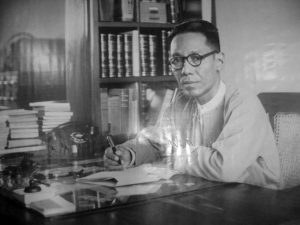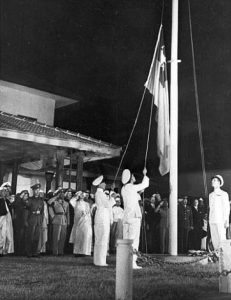By Myint Swe Oo
After obtaining B.A degree in 1933, Sayagyi Min Thu Wun entered service as a part time tutor at the Department of Oriental Studies of Rangoon University. The university students were already politically alert, then. Sayagyi believed that these youths would be the future architects of Myanmar’s independence because he had learned their ardour for the Independence from his personal contacts with these students, as well as from the literary talks and the articles and novels.
Colleges were not closed on the National Day that fell on 10th waning day of Tazaungmon, but on that day, instead of attending classes, the students marched towards the ceremony of the National Day.
It was quite a challenge to celebrate such an occasion in groups while the country lay under the British colony.
Auspicious Greetings
On the National Day that fell on 30 November, 1934, all the colleges were closed. Sayagyi Min Thu Wun and his fellow students went to the south west passageway of the Shwedagon and attended the National Day celebration, bowing to the National Flag in unison. Pamphlets of Greetings, published by the Youths Kyee Pwa Ye Association, were exchanged among the students on that day.
It was a postcard size, on one side showing some ladies bowing to the Peacock Emblem Flag, and on the other size bearing a short poem, composed in the traditional Laysit style, which was composed by Min Thu Wun at the request of Kyee Pwa ye U Thein. The title of the poem is “Auspicious Greetings”. The phrase “the somber grey Hill” implies “The Singuttara Hill”.
The south west slope of the Shwedagon was a part of the hill where the Goyya soldiers of the British army were camped, known as the Goyya Hill. But later, because of the the lack of political stability, the troop moved out. The National Day celebration usually took place there at the spacious site. It was said that the sight of the students bowing to the National Flag stirred the hearts of the beholders.
Sayagyi Min Thu Wun won a scholarship in September 1936, and studied Sanskrit, Pali and Tibetan studies at Oxford University, England.

Frozen Climate
A small village named Beckford is located near Chester, England. The Priest A.H. Valenko of Beckford was Saya Min Thu Wun’s former teacher: he was the headmaster of Saya Hmat’s School in Yangon. On their meeting in the Oxford University, the priest gave suggestions to the Myanmar scholar. During the Christmas, which was the time for college vacation, it was a frozen season, so it was not fit for an outing. So Min Thu Wun was advised to come and study at the St. Deiniol Library. So during 1936 Christmas, Saya Min Thu Wun went and studied at the Library. When the Christmas came in 1937, he went to St Deiniol Library and spent time reading there. However, on this visit, he was accompanied by the late U Ohn Maung (one of the martyrs of Myanmar).
Of Being One Mind
Saya Min Thu Wun felt the repercussions of 1300 Myanmar political movement. After Christmas, the new year 1938 was ushered in, and on 4 January, Saya Min Thu Wun wrote the poem Thabye Nyo, and sent it to a magazine in Myanmar. The poem appeared in print in No. 1, Vol. 7, O-Way Magazine (1938).
Saya Min Thu Wun wrote this poem because he could picture in his mind that the Myanmar people stood united, striving selflessly and unanimously for the independence. Taking for granted that the Independence was on the way, as he said, he had written this poem.
Saya Min Thu Wun also said that his poem “Thabye Nyo,” being an echo to the poem “Auspicious Greetings”, could be considered as a sequel to the latter.
It happened, quite a coincidence, that, on 4th January 1948, exactly ten years after Thabye Nyo had been written, Myanmar regained her independence.
(Translated by Zaw Tun)



